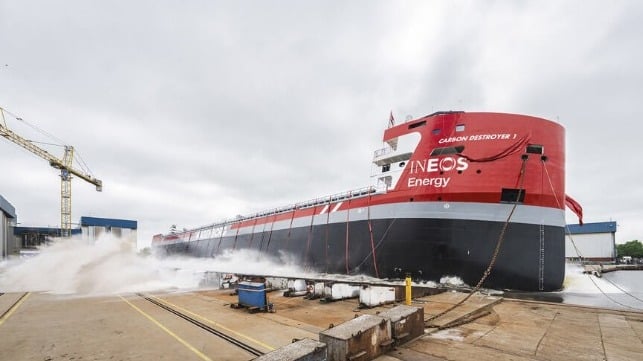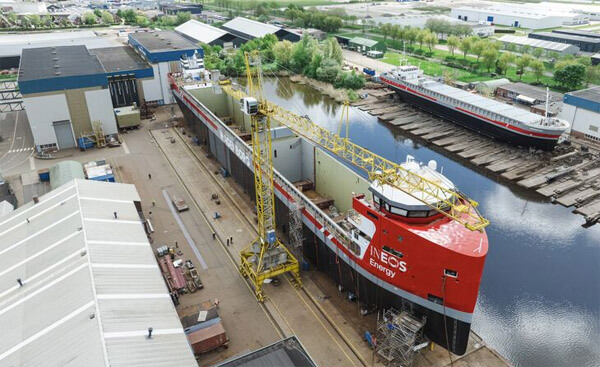Video: Carbon Destroyer 1, EU’s First CO2 Carrier for CCS is Launched

The first European-designed and built carrier for liquified CO2 to be used in a carbon capture and storage operation was launched on May 14 in the Netherlands. The vessel is being called a breakthrough designed to support a commercial-scale CCS project for the EU.
The launch took place at the Royal Niestern Sander shipyard. The Carbon Destroy 1 will have a capacity to transport approximately 5,000 tons of liquified CO2 as part of the Greensand Future project. The vessel will operate between the Port of Esbjerg in Denmark and the Nini West offshore platform, a depleted oil field in the Danish North Sea. The project, which is being led by INEOS, in March 2023, became the first to transport CO2 across international borders and completed a pilot injection of the CO2 beneath the seabed in the depleted field.
Carbon Destroyer 1 is based on Royal Wagenborg’s EasyMax shortsea bulker design and has been especially adapted for the handling of CO2 under pressure and at low temperature. The concept for the bulker class is a multi-purpose vessel with a cargo capacity of 14,000 tons, which was jointly developed by Royal Wagenborg and Royal Niestern Sander to produce a vessel requiring lower power output and achieving greater efficiency. The class is based on a design length of 492 feet (149.95 meters), a beam of 52 feet (15.9 meters), and a draught of 28 feet (8.6 meters), which also provided an enlarged cargo capacity.
Mads Weng Gade, CEO of INEOS Energy Europe, highlighted that “Carbon Destroyer 1 will transport captured CO2 from across Europe, creating a virtual pipeline between the point of capture and permanent storage deep beneath the seabed of the North Sea.”
Work has begun on a CO2 terminal to be located in the Port of Esbjerg, in the southwest of Denmark on the North Sea. The initial plan calls for captured CO2 from Denmark’s biogas plants to be delivered by truck to the terminal, where it will be stored and then transferred to the vessel.

Carbon Destroyer 1 ready to launch (Greensand Future)
The vessel is expected to be fully operational by the end of 2025 or early 2026, with its delivery coordinated to the projected start date for commercial operations for Greensand. The project calls for storing CO2 over 1,800 meters beneath the seabed. Initially, Greensand aims to capture, transport, and store 400,000 tons of CO2 per year. It has the potential to gradually increase its storage capacity by 2030. The project, which is a partnership between INEOS Energy Denmark, Harbour Energy, and Nordsøfonden, which is the Danish state’s subsurface company, reports that there is potential for permanent storage of up to 8 million tons of CO? annually.
Carbon Destroyer 1 is larger than the two South Korean-built vessels that were delivered at the end of 2024 for Norway’s Northern Lights CCS project. Those vessels each have a capacity to transport 7,500 cbm of LCO2. They have completed certification and as of last week, Norway’s Ministry of Energy, the Ministry of Climate and Environment, the Norwegian Environmental Agency (NEA) and Norwegian Ocean Industry Authority (Havtil), have all given their consents for the first phase of Northern Lights. It now has all the required permits to begin injecting CO2 at its site in the North Sea off the Norwegian coast.
